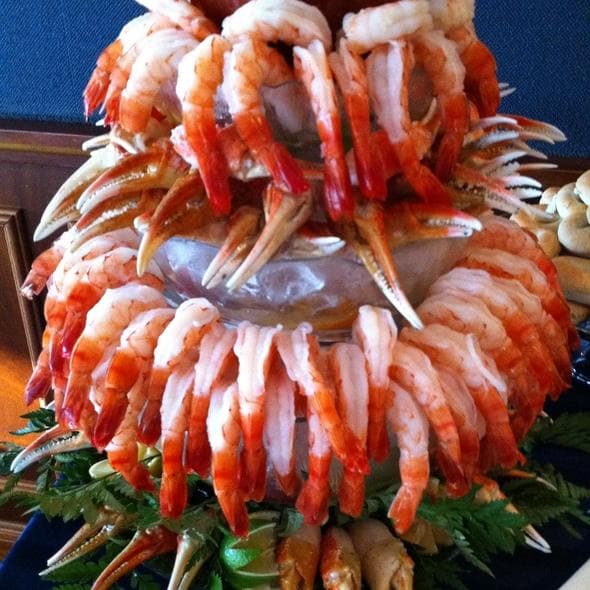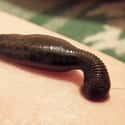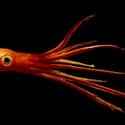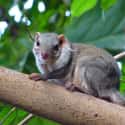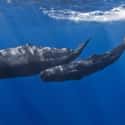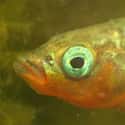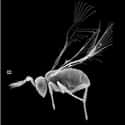-
(#1) Crow
- Corvus
If you’ve ever been unsettled while walking through a park because you caught the piercing black eye of an idling corvid - the bird family to which crows, ravens, and their ilk belong - you were right to be wary. A study done in 2004 indicated that corvids may have the reasoning power of some nonhuman primates.
How smart are corvids? They may very well be among the most intelligent animals on earth. The study found these birds figured out how to rid themselves of parasites by using ant formic acid, learned how to use passing cars as a means to crack nuts, and they are extremely self-aware.
-
(#2) Leech
- Hirudinea
The internal structure of the average leech is divided into 32 equal segments. Each of those segments has its own brain. Technically each segment has one ganglia - a structure containing a number of nerve cells - that belongs to one 32-segment structure, but the distinction is moot in practice. The thing has 32 brains. The first four sections of the brain are dubbed the "anterior brain" and contains the leech's signature sucker.
The brain isn’t the only thing that leeches double-up on. They’ve also got a matching set of reproductive organs and nine pairs of testes. Another fun fact: leeches are considered hermaphrodites.
-
(#3) Spider
- Araneae
There are several members of the spider species that house their brains in their heads. However, as spiders tend to decrease in size, their brain size actually increases proportionately to the point that the tiniest members of the species have the evolutionary problem of trying to cram an oversized brain into a space that’s simply too small.
As a result, the brains of some minute spiders spill over into their body cavities and legs. Some of the smallest spiders will actually develop bulges on their body where their brain is spilling over. Because brains use a lot of energy - and because spiders are typically so small - a lot of the food spiders eat go directly to powering their brains.
-
(#4) Giant squid
- Architeuthis
In spite of the fact that a giant squid can reach up to 1,500 pounds, their brains only clock in at about .2 pounds. Even stranger, those brains are wrapped around the giant squid’s esophagus. The hole the squid’s esophagus runs through is only about .4 inches. Because of this, the animal is forced to shred its food into tiny bits to avoid giving itself brain damage.
Fortunately, the giant squid is doing okay for two big reasons. First, it doesn’t eat a lot. And second, it simply floats around until food wanders into its eye line, at which point it reaches out one of its giant sucker-covered tentacles and snatches its dinner.
In other words, it makes sense the brain and esophagus have a kind of symbiotic relationship within the giant squid, because what little thinking it does is related directly to its consumption of food. The giant squid hardly has a complex approach to hunting.
-
(#5) Tree Shrews Have The Highest Brain-To-Body Mass Ratio Of Any Mammal
Though it’s not always accurate, a lot of scientists still put a lot of faith in measuring intelligence by the ratio of brain mass to body mass. By that token, humans are actually fifth in the pecking order of intelligence. The mammal that scores the highest? The tree shrew.
That extra brain power has imbued in the tree shrew a positively weird assortment of abilities, like drinking fermented nectar without getting drunk, for example. They have also developed pretty extensive symbiotic relationships with several types of plants.
-
(#6) Ascidiacea
- Ascidiacea
When it first pops out of its egg, the sea squirt looks surprisingly like a tadpole. It swims through the water, using its brain to figure out the complexities of swimming, until it finds a suitable spot to plant.
Once the sea squirt has picked its resting spot, it hunkers down and literally eats its own brain. From that point forward, the sea squirt will rely solely on its automatic processes to nourish itself and propagate the species.
-
(#7) Cockatoo
- Cacatuoidea
In 2013, a team of scientists concocted a plan to have cockatoos decipher a “series of interlocking devices, each of which jammed the next lock along” in order to retrieve a nut. And, to the scientists' surprise, the cockatoo actually succeeded.
Even cooler, once a cockatoo had successfully figured out how to pick a lock, they remembered the solution in the future. Cockatoos who couldn’t figure out the locks, meanwhile, could typically complete them after watching another bird go through the solution.
-
(#8) Sperm Whale
- Physeter macrocephalus
At an average of about 16 pounds, sperm whales have the largest brain of any living mammal. That might sound like a lot, but when you consider sperm whales can get up to 63 tons, it’s not super impressive.
In fact, scientists believe the sperm whale’s one-of-a-kind noggin was actually made for ramming other whales. The theory spawns from the sperm whale’s long history of sinking ships for no apparent reason. A sperm whale was the inspiration for Moby Dick.
Though the whale’s head is huge, most of a sperm whale’s cranium is composed of “two large, oil-filled organs stacked one on top of the other - the spermaceti organ on top, and another below it called the junk.” According to scientists, partitions in the connective tissue inside the junk actually helps reduce stress when the sperm whale uses its head to smash into stuff.
-
(#9) Dolphin
- Delphinidae Delphis
It should come as no surprise that several scholars wonder whether dolphins are actually smarter than humans. The reasoning behind this is the dolphin’s amazing brain, which can be as complex as that of a human. While humans beat them in terms of brain-to-body-weight ratio, dolphins are right behind humanity as the second most encephalized beings on the planet.
Even more intriguing, dolphins have a larger neocortex than human beings. The neocortex is responsible for problem-solving, self-awareness, and a huge array of other behavior we typically associate with humans. Their brains also contain the components that govern emotions, empathy, and even recognition of a social structure.
-
(#10) Three-spined stickleback
- Gasterosteus aculeatus
Native to Iceland, the three-spined stickleback is a one-of-a-kind species. One thing that makes it really unique? The male of the species have a much larger brain than the female. In fact, the three-spined stickleback is the only known species with this aberration.
The prevailing theory to explain this disparity is that the male of the species has a longer list of chores in his day-to-day life. Males have to defend territory, build a nest, change their skin pigment, and then look after any kids. The female of the species just shows up, lays eggs, and then takes off. All that said, scientists still aren’t sure if the physical difference in brain size adds up to a cognitive advantage for males.
-
(#11) Woodpecker
- Picinae
Have you ever wondered why woodpeckers aren’t doing serious damage to their brains when they spend most of their day literally beating their heads against a tree? A really thick, sponge-like skull, that’s how. Scientists in Beijing discovered that woodpeckers' skulls are composed of thick formations of plate-like bone that have several trabeculae, “tiny, beam-like projections of bone that form [a] mineral ‘mesh’” that acts as armor protecting the woodpecker’s brain.
The woodpecker’s entire head is a miracle of evolution. Not only is the bird’s skull miraculous, but scientists have previously discovered woodpeckers have thick neck muscles that help absorb the speed and force of their blows, as well as a third eyelid that prevents the woodpecker’s eyes from popping out of its skull when it hits a tree.
-
(#12) One Insect Brain Fungus Can Revive Dead Ants
Scientists speculate the poor Camponotini carpenter ants have been the victim of a vicious, zombie-fying fungus known as the Ophiocordyceps parasitic fungus for almost 50 million years.
When infected, a carpenter ant will descend from its arid canopy and stumble around on the humid forest floor. They wander aimlessly, suffering from sporadic convulsions that make them fall down. At this point, the ant itself is dead and the fungus is in control. Toward the end of the disease, a zombie ant will “stop on the underside of one leaf … and clamp down on the leaf's main vein.” At that point, the ant’s body will die and the fungus will sprout from its head, feeding off the corpse and the plant until it can grow and release spores that are eaten by more unsuspecting ant victims.
-
(#13) Wasp
The Megaphragma mymaripenne is a species of wasp. Don’t be fooled by the “mega” in its name, though. At just a fifth of a millimeter in length, Megaphragma mymaripenne is actually smaller than an amoeba (and it’s not even the smallest insect on record).
It is pretty miraculous, though. In spite of being legit pint-sized, this wasp has a fully formed set of eyes, wings, muscles, guts, and even a fully formed brain and nervous system. Scientists have long been in awe of the wasp’s nervous system, despite it only having a measly 7,400 neurons. By comparison, a honeybee’s nervous system has 850,000 neurons.
Still, even armed with that puny messaging system for its brain, it can fly, hunt, and do all the normal stuff a wasp does. Even crazier, most of its neurons don’t even have a nucleus, which means they shouldn’t even be able to function. And yet they do, and the species lives on, and scientists are totally stumped by it.
-
(#14) Cavalier King Charles Spaniel
The next time you need an argument in favor of visiting a pet rescue instead of buying from a breeder, consider the case of the poor Cavalier King Charles Spaniel. Thanks to years of inbreeding, the spaniel’s skull can actually be too small to accommodate the entirety of the cerebellum.
In addition to a series of medical problems, the issue typically manifests as the animal using its back leg to scratch the air (it’s aiming for the base of its neck.)
New Random Displays Display All By Ranking
About This Tool
The animal brain is a mysterious and magical organ. It is like a microbiological computer, dominating all the thinking and behavior of the owner. Differnt animal brains have different shapes and functions, some are just a small cluster of nerve cells, while others are as complex as a human brain. For example, the spider's brain can overflow to its own legs, while the sea squirt continuously digests its own brain during its growth.
There are a variety of strange animals in the animal kingdom that have fascinated mankind. Over the centuries, with the advancement of science, many mysterious animal brains have gradually become known. The random tool introduced 14 incredibly fascinating animal brains.
Our data comes from Ranker, If you want to participate in the ranking of items displayed on this page, please click here.

